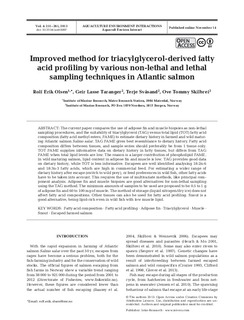| dc.contributor.author | Olsen, Rolf Erik | |
| dc.contributor.author | Taranger, Geir Lasse | |
| dc.contributor.author | Svåsand, Terje | |
| dc.contributor.author | Skilbrei, Ove | |
| dc.date.accessioned | 2014-02-11T11:42:45Z | |
| dc.date.available | 2014-02-11T11:42:45Z | |
| dc.date.issued | 2013-11-14 | |
| dc.identifier.citation | Olsen RE, Taranger GL, Svåsand T, Skilbrei OT (2013) Improved method for triacylglycerol-derived fatty acid profiling by various non-lethal and lethal sampling techniques in Atlantic salmon. Aquacult Environ Interact 4:251-261 | no_NO |
| dc.identifier.issn | 1869-7534 | |
| dc.identifier.issn | 1869-215X | |
| dc.identifier.uri | http://hdl.handle.net/11250/109331 | |
| dc.description.abstract | The current paper compares the use of adipose fin and muscle biopsies as non-lethal sampling procedures, and the suitability of triacylglycerol (TAG) versus total lipid (TOT) fatty acid composition (fatty acid methyl esters, FAME) to estimate dietary history in farmed and wild maturing Atlantic salmon Salmo salar. TAG FAME gives best resemblance to dietary history. Fatty acid composition differs between tissues, and sample series should preferably be from 1 tissue only. TOT FAME supplies informative data on dietary history in fatty tissues, but differs from TAG FAME when total lipid levels are low. The reason is a larger contribution of phospholipid FAME. In wild maturing salmon, lipid content in adipose fin and muscle is low. TAG provides good data on dietary history, while TOT is less informative. Escapees are well identified analysing 18:2n-6 and 18:3n-3 fatty acids, which are high in commercial feed. For estimating a wider range of dietary history after escape (switch to wild prey), or feed preferences in wild fish, other fatty acids have to be taken into account. This requires the use of multivariate methods, like principal component analysis. Adipose fin and muscle biopsies are good alternatives for non-lethal sampling using the TAG method. The minimum amounts of samples to be used are proposed to be 0.5 to 1 g of adipose fin and 60 to 100 mg of muscle. The method of storage (liquid nitrogen/dry ice) does not affect fatty acid compositions. Other tissues can also be used for fatty acid profiling. Snout is a good alternative, being lipid-rich even in wild fish with low muscle lipid. | no_NO |
| dc.language.iso | eng | no_NO |
| dc.publisher | Inter-Research | no_NO |
| dc.title | Improved method for triacylglycerol-derived fatty acid profiling by various non-lethal and lethal sampling techniques in Atlantic salmon | no_NO |
| dc.type | Journal article | no_NO |
| dc.type | Peer reviewed | no_NO |
| dc.subject.nsi | VDP::Agriculture and fishery disciplines: 900::Fisheries science: 920::Aquaculture: 922 | no_NO |
| dc.subject.nsi | VDP::Agriculture and fishery disciplines: 900::Fisheries science: 920::Fish health: 923 | no_NO |
| dc.source.pagenumber | 251-261 | no_NO |
| dc.source.volume | 4 | no_NO |
| dc.source.journal | Aquaculture Environment Interactions | no_NO |
| dc.source.issue | 3 | no_NO |
| dc.identifier.doi | 10.3354/aei00087 | |
